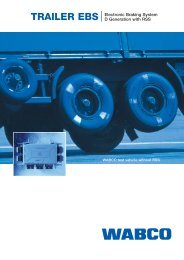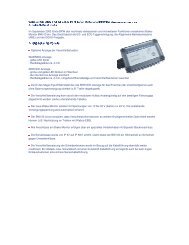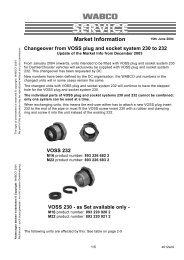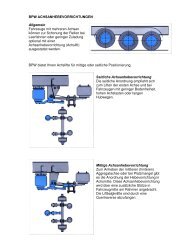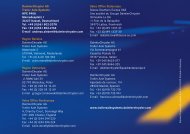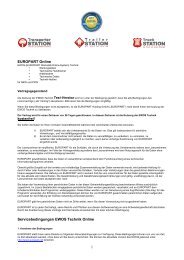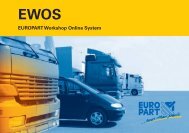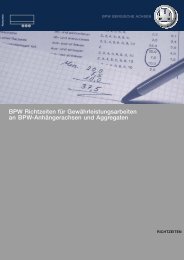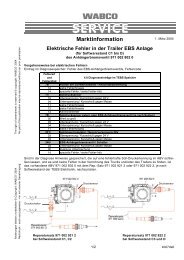Brosch. Trailer EBS (E) - wabco inform
Brosch. Trailer EBS (E) - wabco inform
Brosch. Trailer EBS (E) - wabco inform
Create successful ePaper yourself
Turn your PDF publications into a flip-book with our unique Google optimized e-Paper software.
<strong>EBS</strong> 25<br />
Compatibility of<br />
Towing Vehicle and <strong>Trailer</strong><br />
Fig. 18: Adjusting the Band Position by Response<br />
Pressure Recognition<br />
band position, causes the retardation<br />
characteristics of the individual parts of a<br />
vehicle combination to be almost identical<br />
within the range of lower brake pressures,<br />
thereby achieving the most even lining<br />
wear possible on both vehicles within a<br />
tractor-trailer combination. In addition,<br />
total wear is reduced since the mean<br />
temperature level of the wheel brakes is<br />
reduced by optimizing brake force distribution.<br />
The improvement in compatibility<br />
through <strong>EBS</strong> is also achieved by means<br />
of a dynamic change of the band position,<br />
including the adaptation of the<br />
response pressure during the braking<br />
process, although the basic design of the<br />
individual parts of the tractor-trailer combination<br />
still has to lie within the compatibility<br />
band. For reasons of compatibility,<br />
the new <strong>EBS</strong> regulations allow a dynamic<br />
change of the towing vehicle’s band position<br />
ony, i. e. the position of the trailer<br />
within the compatibility band must not be<br />
subject to any dynamic change during<br />
the braking process.<br />
The change in the band position on the<br />
towing vehicle can be achieved by controlling<br />
the brake cylinder pressures<br />
and/or the hose coupling pressure.



